Bonaire
Netherlands Antilles
Jan. 2004
Intro:
Anyone who has read my previous trip reports knows that Susan and I tend to
like to go to Club Med resorts for sailing and windsurfing. But we also like to
break out of the mold occasionally and try something (and some place)
different. This time we decided we wanted to work on our windsurfing skills a
little and go some place different. Since this was January, it also had to be
WARM!. We had overheard some other travelers talking about Bonaire and we knew
that Bonaire was supposed to have a great windsurfing area (good enough that
some say it is better than Aruba's "Fisherman's Huts" area). It also
has a reputation for good (excellent!?) snorkeling, which is another of our
preferred activities. But, there are none of our normal 'resorts' on Bonaire
and air travel is limited, so it was a bit of a challenge (on a budget, anyway).
Getting there (and back):
I wanted to use Delta frequent flyer miles to get us to Bonaire, but could only
get 'close'. By using Delta "Sky Choice" award tickets, we were able
to get to Aruba. (Don't get me started on what I think of Delta's FF seat
allocations...) So we took Delta to Aruba and then a new airline, Bonaire
Excel, from Aruba to Bonaire. Although I had heard some bad stories about
Bonaire Excel's startup, our flights were on time and comfortable using modern
equipment (ATRs). On the return trip on Saturday via Aruba, the Aruba airport
was a true madhouse. Looonnnggg lines everywhere. It seemed that everyone in
Aruba was trying to leave that day. The only good thing is that Delta did
upgrade us to first class on the way back. I guess they felt a little guilty
about how many FF miles the trip costs us.
Accommodations:
After some research we settled on the Kon Tiki (Lac Bay) apartments. This is a
small (probably 10-12 units) facility on the edge of Lac bay, where the
Windsurfing is. It is truly out by itself, more than we had expected it to be.
The only other facilities anywhere close by (within about 7 or 8 miles) are the
windsurfing 'outfitters' and the Sonora Beach resort (a "naturalist"
resort, which we decided against). The Kon Tiki arranged for the windsurfing
rentals (at a slight discount) and a rental car (which is needed).
The Kon Tiki provides apartments, with a living room, kitchen, bedroom and
bath. Lots of room to spread out. While we did not miss a TV, we would have
liked to have screens across the sliding door to keep out the relatively small
and non-aggressive mosquitoes. Then again, chasing the mosquitoes that did get
in provided some entertainment during the otherwise very quiet evenings. We had
a 2nd floor apartment with a view out across the flat part of Bonaire and out
over the bay where the windsurfing took place. The Kon Tiki has a small
restaurant as part of the resort and during the winter season the Kon Tiki
includes breakfast with the cost of the room. They served a very good and
complete European style breakfast, although it was starting to get a bit boring
by the end of the week. There was so much breakfast that we took some of it to
make small sandwiches that we used for lunch. We ate dinner there three
evenings and they served very good meals. The chef obviously took pride in the
preparation and presentation of the food.
A little geography:
Bonaire is one of the "ABC islands": Aruba, Bonaire, Curacao. Bonaire
is the middle sized island of the three, and has the smallest population (about
16,000). It is about 50 miles north of Venezuela and the weather (and
surrounding water) is always warm. It is mostly a dry desert-like island with
lots of cactus growing in the open areas. However, we were there during the rainy
season and we got some rain every day, but it didn't really get in our way very
much. Besides tourism, the main industry is sea salt; there are large salt
evaporation ponds on the eastern end of the island. There are some hills on the
northern and western sections of the island and they offer some nice views. The
island is mostly volcanic in nature (none active now) and the soil is rocky and
hard. As in Aruba, most of the population speak English, Spanish, Dutch, and
the native Papiamento so there are seldom any language issues. US dollars are
welcome, but you will probably get change in N.A. Florins (also referred to as
Guilders).
The Windsurfing:
We went mainly for the windsurfing, so how was it?? In a word, great....People
who had been there for a while said that there had been virtually no wind for
the previous two weeks. The week we were there, there was reasonable to good
wind every day, for at least part of the day. Lac Bay is on the eastern end of
the island and gets the full force of the trade winds with nothing to get in
their way. There is a good reef to cut the swells/waves down to ripples. Much
of the bay is shallow, ranging from about 1 ft. to 3 ft, depending on the tide.
The water was clear and warm with good areas to start from. There are two
outfitters and we used Jibe City, but the other facility looked good also. They
offer lessons, but really didn't seem to have their heart in that activity. The
equipment was good, with excellent sail/mast/boom kits and OK, but not great,
boards. (I'm just a beginner/intermediate windsurfer, so take this with a grain
of salt.) When the wind got good some of the areas got rather busy, with the
more experienced windsurfers tending to (unintentionally, I'm sure) intimidate
the less experienced with their speed and maneuvers. My impression was that the
bay was slightly better for windsurfing than Aruba. The facilities are not
quite as nice, but the natural characteristics are better. The only thing that
occasionally stopped us (other than lack of wind) was low tide: when the tide
was low, some of the bay was just too shallow to sail across without dragging
your fin. 90% of the time, though, it was great.
Snorkeling:
Bonaire is known mostly for its' diving and snorkeling spots. Unlike most
islands with diving spots, almost all of the Bonaire dive (and snorkeling)
locations can be reached from the shore; no boat required. Dive and snorkel
locations are marked with yellow rocks along the road and there are several
maps available that list all the dive locations, their characteristics, and
their name (which is painted on the yellow rocks). Once you understand how it
works, you can easily locate any of the eighty-some dive spots. However, the
same characteristics that make shore dives possible also mean that there are
essentially no soft sandy beaches. All beaches we saw are really hard rocks and
coral. Getting into the water was sometimes a challenge. But once in the water,
there were very nice reefs and coral areas. The sea floor seemed to drop off
very close to shore, so the transition from shallow to deep was within easy
snorkeling distance. For SCUBA divers there are a large number of dive shops
and outfitters. If you don't have (or take) your own snorkel gear, there are
numerous snorkel tours available which will provide the equipment. The only
real 'caution' is that there appears to be a problem with locals breaking into
cars parked at the more remote dive spots. The general suggestion is to not
take anything valuable and leave the car unlocked so it is not "broken"
into.
Time to eat:
As previously mentioned, we ate breakfast at the Kon Tiki and that also
provided much of our lunch. We stopped at a local food store and got some
crackers and fruit and didn't buy a normal 'lunch' any day. We ate dinner at
the KonTiki three nights and it was very good. Other nights we went into the
main town, Kralendijk, and found places to eat. We never had a 'bad' meal, and
they ranged from 'respectable' (at a Mexican food place) to very good (at an
Italian restaurant). Prices were reasonable; certainly not 'cheap', but very
little more than we would pay at comparable restaurants in the US, and much
less than, for example, Grand Cayman. Most meals for two, with a glass of wine
or a beer apiece, ran around $40 to $50. The emphasis is naturally on fresh
fish. One evening while eating at the City Grill a truck stopped in front and
the guys got out and pulled three large, very(!) fresh, fish (Wahoo?) out of
the back of the truck and carried them into the kitchen.
General comments:
For anyone doing a lot of windsurfing, or anyone just wanting to relax in a
very quiet and peaceful area, I would certainly recommend the KonTiki. Anyone
with a primary interest in diving or snorkeling would probably be happier in
town at one of the more centrally located resorts. Anyone wanting to learn to
windsurf should consider Bonaire, but perhaps during a season with slightly
less robust winds. Lighter winds are better for beginners and also means that
there will not be as many advanced windsurfers zipping around. There was a
definite difference between Aruba and Bonaire. Although Aruba is marketed at
"The Happy Island" (and it is), Aruba is much more developed and
commercialized than Bonaire. Bonaire is still very relaxed, definitely
friendly, with few of the Americanized restaurants and such. Bonaire is more
like a European community (in a warm climate) compared to Aruba which is more
like an American city. A few cruise ships stop at Bonaire, probably two or
three a week. On days where there was ship in port there were many vendors
around the dock and much more activity in town. Something to either see or
avoid, depending on your preferences. If you stay in a centrally located resort
in town and use the in-town dive operations, you may not need a rental car.
Most people, however, will probably end up renting a car for at least part of
the time.
Sample Photos
Lac Bay (Eastern tip of Bonaire) from the air
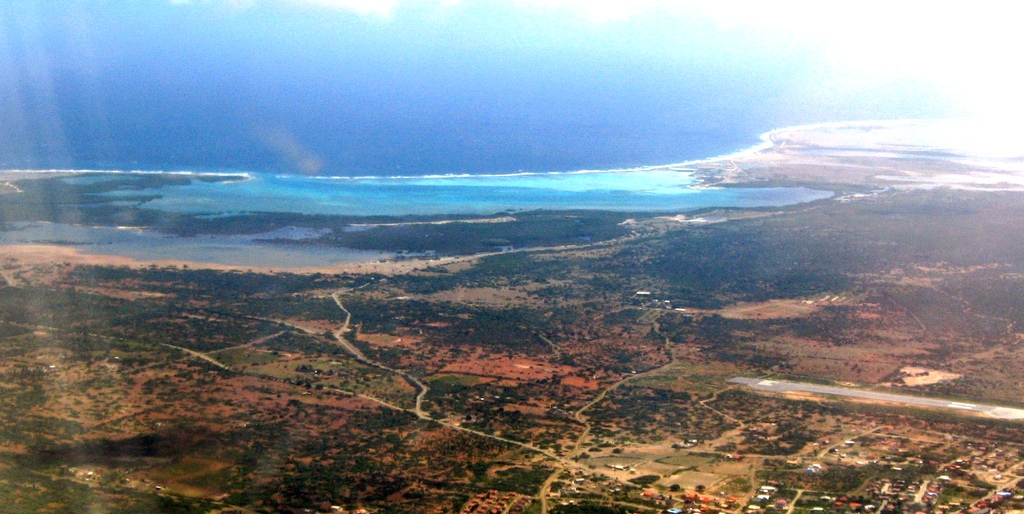
In the water at Jibe City Windsurfing
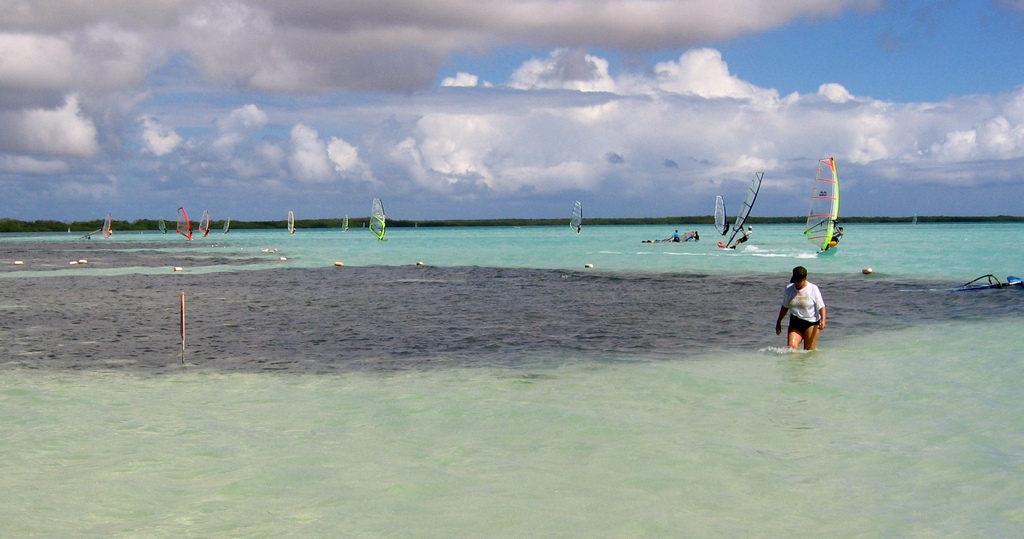
Some of the windsurfing boards racked up.

Kitesurfers on the southeastern tip of Bonaire.
(No, we didn't try that!)

Our view of the windsurfing action from our room's porch..
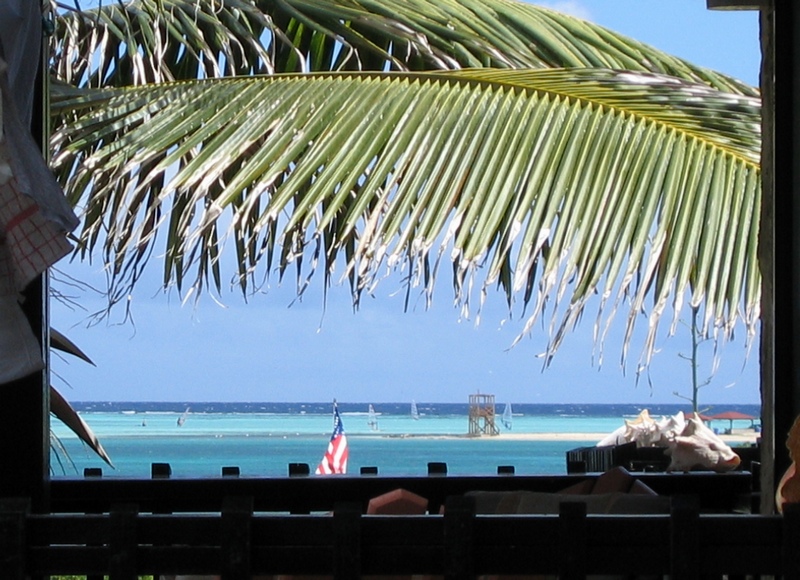
Entry to one dive site: note the yellow rocks with the site
name.
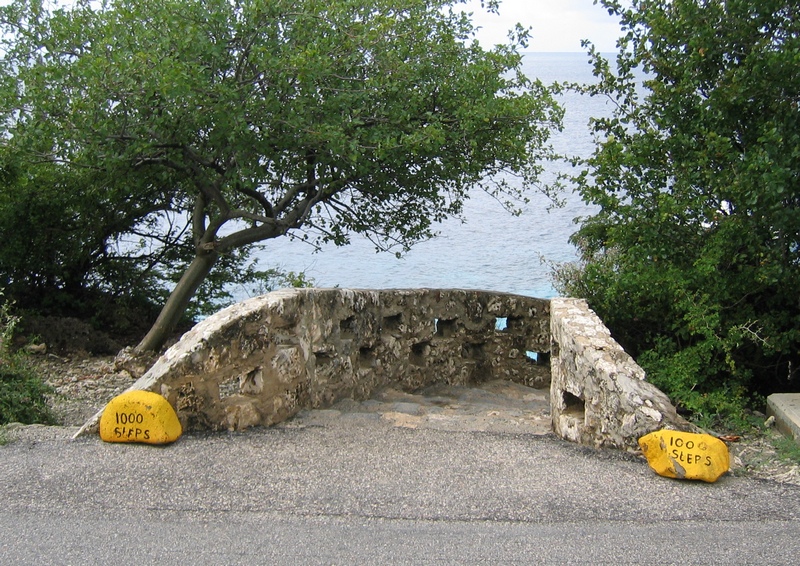
One of the dive/snorkel sites (1000 steps) from above.
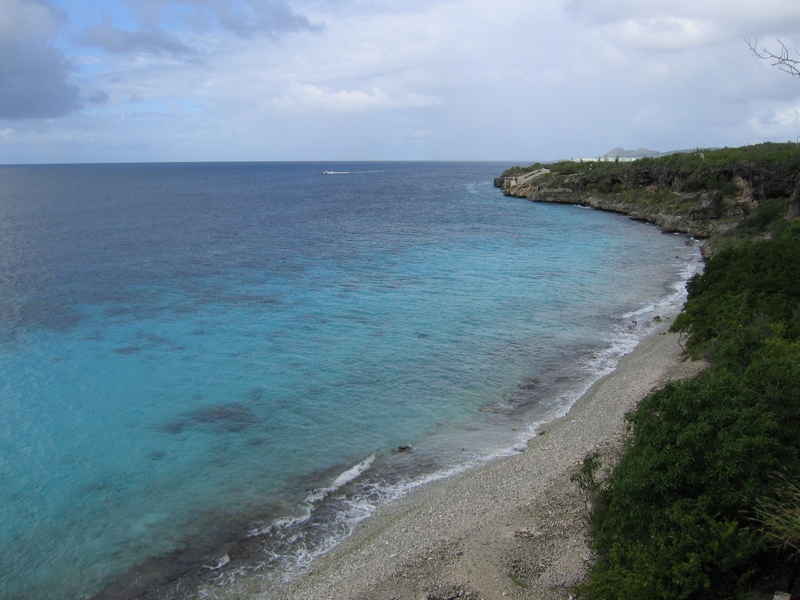
A lake and some terrain on the western part of Bonaire.
